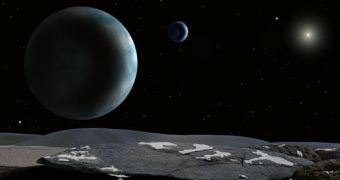Two years after it was stripped of its privileges as a planet, Pluto takes a new hit coming from the International Astronomical Union which has taken it out of the dwarf planet family and placed it into a rather strange new one called 'plutoids'. The IAU decided in 2006 that Pluto should be demoted from the rank of planet to that of dwarf planet, which is basically an object with gravitational pull strong enough to shape it into a spherical object, but not enough to clear its orbit of debris. In the same session that voted Pluto out of the planet family, astronomers suggested that it should also have an alternative name. Therefore, from now on, objects resembling Pluto and its larger neighbor Eris will be called plutoids.
Plutoids are defined as objects with sizes comparable to that of Pluto that spend most of their time in orbits beyond that of Neptune and bear a specific brightness. Now, the first two properties of the objects falling in the plutoid family are understandable, but most astronomers don't quite understand what brightness has to do with everything. Frankly, neither do I.
"In the end, we ended up with something Pluto-like, and I don't think we could have done better", said Karel A van der Hucht, general secretary of the IAU.
"It sounds like 'hemorrhoid' and it sounds like 'asteroid', and of course these objects are planets and not asteroids", says Alan Stern, a planetary scientist from the University Space Research Association, while criticizing the decision reached by the IAU.
Stern believes that the IAU's definition of a planet is flawed, and the fact that the vote deciding the name of Pluto-like objects was not open is a sign that it's not going to last for very long. "I think this pronouncement is one more step in the IAU's increasing irrelevance. The IAU could announce tomorrow that the sky is green, but that doesn't make it so", he added.
Van der Hucht on the other hand reckons that the IAU is not pressuring people on how to name various objects in the solar system, albeit it will help researchers during their investigations. Although Ceres is also a dwarf planet and has most of the properties of plutoid objects, it cannot be classified as one simply because it does not lie in an orbit beyond that of Neptune.
Alternatively, only dwarf planets of a certain minimum brightness will be classified as plutoids, leaving most of the dwarf planets outside Neptune's orbit out of the plutoid family.
"That's an odd definition. It makes objects of exactly the same size 'plutoids' or 'not plutoids' depending on what's covering their surface", said Michael Brown from Caltech. Say Pluto had been covered with dust instead of ice, what then?

 14 DAY TRIAL //
14 DAY TRIAL //